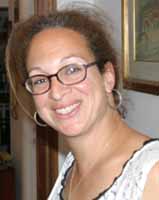
|
|
|
| Grottoes
Vatican City Colonnade Saints Floorplan #2 |
| Altars
Monuments The History Chronology |
| Related
Links Scala Sancta Zenit |
|
Code: ZE04040822 Date: 2004-04-08 The Pietą, in Photos; "The Passion" in Italy A Moving Exhibit on a Michelangelo Masterpiece By Elizabeth Lev ROME, APRIL 8, 2004 .- Few images of Christ's passion rival the evocative Pietą. Though often associated with Michelangelo's statue of the same name in St. Peter's Basilica, the name "pietą" refers to any representation of the Virgin Mary mourning over the body of the dead Christ, usually shown held on her lap. In fact, Michelangelo himself produced not one, but four separate Pietą statues during his artistic career. I thought it might be appropriate to start out my Holy Week by visiting the Pietą show that opened on March 18 in the Charlemagne wing near St. Peter's Basilica. With this show it seemed that the Vatican was resurrecting a lost Lenten usage of temporarily placing terracotta statues in churches to assist the faithful in contemplating Christ's passion. Struggling through the post-Palm Sunday crowds and persuading the police and "carabinieri" that my entering the Charlemagne wing posed no threat to the president of Costa Rica who was visiting the Pope that morning appeared so daunting that I thought I might turn back. But the moment I entered the exhibit I was transported to another world. Truth be told, I was not expecting a great deal from this exhibit. It consists of about 150 black-and-white photographs taken by composer and photographer Robert Hupka while Michelangelo's Pietą was on display at the 1964 World's Fair in New York. Hupka's own passion for the work manifests itself in thousands of black-and-white and color photos taken in daylight or by night, featuring frontal and side views, close-ups and faraway shots. I thought I might catch a view or angle I had never seen before. The magnificent artwork has been kept behind bulletproof glass since its restoration following an attack in 1972 by a disturbed artist who hit the statue 15 times with a hammer, knocking off Mary's nose and causing other damage. The new arrangement keeps viewers at a safe distance but also impedes closer inspection. What I got was a deeply moving, contemplative experience. The entrance hall introduces Michelangelo and his Pietąs, concentrating on his first, the well-known Vatican Pietą commissioned by French Cardinal Jean Bilhičres de Lagraulas in 1498 for the St. Petronilla Chapel in St. Peter's Basilica and his last, the Rodanini Pietą, started in 1552 and worked on by the artist at intervals up to a few days before his death in 1564, and which today is housed in Milan. Copies of either Pietą placed at opposite sides of the room help the viewer to see the evolution of this subject matter in the hands of this great artist. From a disproportionately large Mary holding the body of Christ on her lap in the Vatican version, we travel to the other extreme, the Rodanini Pietą where we are not sure if it is she who is supporting the body or if it is her Son's body supporting her. Enlarged images of Michelangelo's studies for the Rodanini Pietą trace the fascinating stages of this development. Stepping further into the pavilion, the entire wing has been transformed. In complete contrast to the sunny spring day outside, the hall was draped in black and the air was chilly. In this tomblike atmosphere, photo after photo of the Pietą lit by hundreds of little spotlights arranged above my head seemed to float along in the dark. The face of the Blessed Virgin dominates the first chamber. From light into shadow, her solemn, resigned expression envelops the visitor, setting a mood of meditation and prayer. In some of the photos, Hupka widened the angle to include the profile of Christ, or a curve of shoulder. Looking at those pictures, the viewer is struck by the brightness of the highly polished surface of Jesus' body juxtaposed to the matte surface of the Virgin. The luminousness of Christ provides a glimmer of hope to the tragic scene. The following section offers views of the Pietą from every possible angle. From the side, from below, in light, in shadow, the Mother and Son are everywhere. Mary cradles her Son, she embraces her Son and she offers her Son in images that force one to reflect on the sacrifice made by both. Then there are Christ's wounds. His hands and feet appear everywhere, sculpted with intense and unnerving precision. Soft skin, protruding veins, slender fingers and toes marred only by nail marks. The pathos of contrasting the limp, folded fingers of Christ with Mary's open hand results in one of the most intensely suggestive photos of the show. At this point the viewer is ready. Glimpses and hints in the earlier photos have awakened the greatest desire of all, to look upon the face of Christ. Penetrating the heart of the exhibition space, the viewer's wish is granted. The exquisitely carved face of Christ is everywhere. There is a serene repose to the smooth planes of his cheeks and brow. In some of the images it almost seems as if Jesus were smiling in serene satisfaction in the knowledge that "it is accomplished." Tearing oneself away from the beautiful visage of Christ, a few images of the back of the group allow the visitor to reluctantly take his leave and to conclude this time of contemplation. But one last large image bars the path. In a novel perspective of the Pietą, we are permitted a "Father's-eye view" as we gaze from above at the shining body of Christ offered up as the perfect sacrifice. The show, "Michelangelo's Pietą, photographs by Robert Hupka," runs through July 23. It is open daily from 10:30 a.m. to 7 p.m., barring papal ceremonies in St. Peter's Square. Tickets are 5 euros for adults and 3 euros for children. * * *
|
